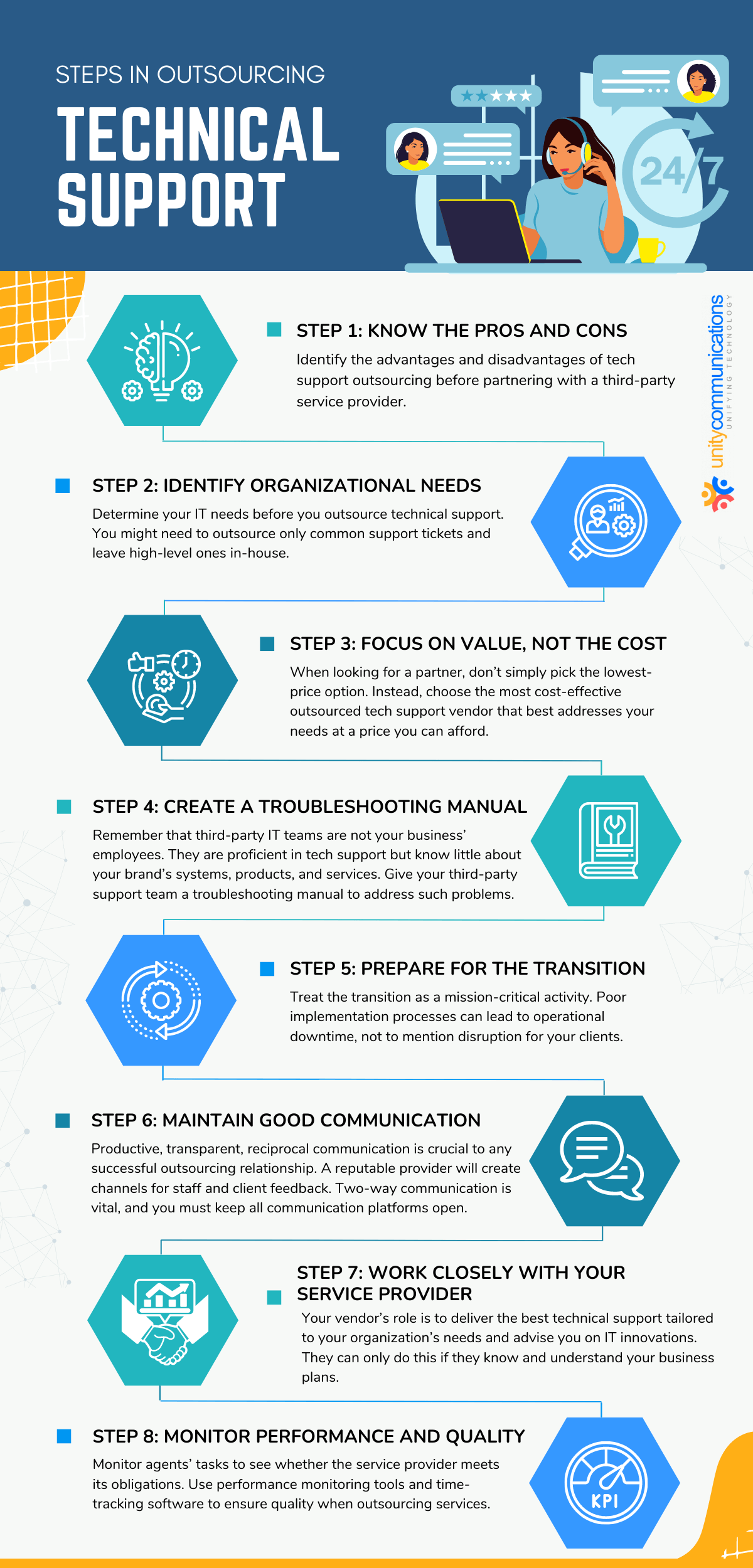Table of Contents
A business’ responsibility is to value customers and their needs. That includes providing technical support, ensuring great customer service, and responding quickly to product inquiries. However, these can be time-consuming functions. That’s where outsourced technical support can help you.
This article guides you through outsourcing technical support. It also covers IT trends in 2024 and why outsourcing has increased and improved.
Steps in Outsourcing Technical Support

Tech support outsourcing involves several steps to ensure that companies get the most from their decision and their dollars.
Step 1: Know the Pros and Cons
Identify the advantages and disadvantages of tech support outsourcing before partnering with a third-party service provider.
There are many advantages to outsourced tech support, such as:
- Flexibility: Scalability and flexibility are crucial for businesses with seasonal needs in the labor force. Back-office outsourcing services have IT support agents available whenever companies need to scale up. Downsizing is also straightforward in times of lower tech support need.
- Access to technologies: Outsourcing providers regularly update their tools and technology. Being up-to-date enables them to provide better service. You can take advantage of this when you outsource to a reputable BPO company.
- Focus on primary competencies: Business executives, managers, and employees can concentrate on more critical aspects of the company. You won’t waste time answering and closing tech support tickets. You can delegate this task instead to IT professionals.
- 24/7 security and peace of mind: Your network does not stop working when you do. After-hours cyberattacks or overnight server outages can cause downtimes and disruptions. Outsourcing technical support ensures that the right technicians are notified of problems.
- Costs reduction: Cost savings are the most appealing benefits of outsourced tech support. The average salary of in-house IT staff is about $63,000 per year. You can save on labor expenses by outsourcing technical support, especially offshore.
Those are only some of the benefits of outsourcing tech support. Meanwhile, the drawbacks include:
- Quality control: You risk losing control over the service quality when you hand off IT support functions to an outside provider.
- Fewer interactions with customers: Outsourcing means receiving customer feedback, but it will first pass through several people before you. You might miss important information in the process.
- Limitation of product knowledge: Outsourced tech support means hiring third-party teams. These contractors are good at general IT support but perhaps not with your products or services.
Step 2: Identify Organizational Needs
Determine your IT needs before you outsource technical support. You might need to outsource only common support tickets and leave high-level ones in-house. Identifying exactly what you need means you pay only for that, not for extraneous, unnecessary services.
Many outsourcing vendors are available in the market, making it hard to choose. After identifying your needs, zero in on the provider that meets your requirements.
Step 3: Focus on Value, Not the Cost
When looking for a partner, don’t simply pick the lowest-price option. Rather, choose the most cost-effective outsourced tech support vendor. That means a third party that best addresses your needs at a price you can afford.
Don’t commit to a provider offering only the bare minimum of outsourced IT support. Go for a partner that actively supports revenue growth and client satisfaction. It should proactively bring continuous value to your business.
Keep value at the forefront when shopping for an outsourcing company.
Step 4: Create a Troubleshooting Manual
Remember that third-party IT teams are not your business’ employees. They are proficient in tech support but know little about your brand’s systems, products, and services. Thus, they will need training before they can deliver quality support.
Give your third-party support team a troubleshooting manual to address such problems. The manual should detail the system, recurring problems, and ways to handle them. Also, include in the manual all specifications you prefer when talking to clients.
Step 5: Prepare for the Transition
Treat the transition as a mission-critical activity. Poor implementation processes can lead to operational downtime, not to mention disruption for your clients.
Don’t just delegate the transition management to a junior office manager, who will act as the facilitator to get the job done. Instead, work directly with key stakeholders within your company, such as senior staff who understand your IT needs.
Key stakeholders can bring their authority and expertise to your outsourcing transition. They can also help get the outside staff on board.
Step 6: Maintain Good Communication
Productive, clear, reciprocal communication is crucial to any successful back-office outsourcing relationship. A reputable provider will create channels for staff and client feedback. Two-way communication is vital, and you must keep all communication platforms open.
- If there is an issue, let your service provider know promptly.
- If things are going great, then let them know.
- Establish a reporting schedule to get the correct data or enough reports.
- Ask your provider how the partnership is from their side and what you can improve.
Draft a policy with your provider that explains your transition communication expectations. Outline the information that needs to be shared from both ends. Integrate your outsourcing partner with your company, whether they are onshore or offshore.
Step 7: Work Closely With Your Service Provider
Your outsourced technical support needs depend on your business structure. Ensure that your service provider knows exactly how your company operates and your tech requirements. Communicate objectives and work closely with them to guarantee the best possible service.
A close working relationship means sharing expansion plans, business strategies, and any competitive threats or IT weaknesses. Your vendor’s role is to deliver the best technical support tailored to your organization’s needs and advise you on IT innovations. They can only do this if they know and understand your business plans.
Step 8: Monitor Performance and Quality
Contractors are often based offshore, making control and compliance of your business complicated. It is challenging for companies that have concerns about quality certifications and audits.
Monitor agents’ tasks to see whether the service provider meets its obligations. Use performance monitoring tools and time-tracking software to ensure quality when outsourcing services.
Other ways to manage an outsourced technical support team include:
- Defining quality and discussing analysis: Poor management and collaboration can reduce visibility when outsourcing technical support. Quantitative quality explanations and in-depth analysis helps measure output.
- Using consistent measurement: You must measure your tech support teams consistently. Are tickets resolved on time and within the expected quality guidelines? Is the team communicating effectively with your stakeholder? Are they completing quality-assurance processes satisfactorily?
- Tracking cycle time: The cycle time is the amount of time that passes from when a task starts to its completion. Tracking this information helps you set realistic expectations for project turnaround times.
- Measuring project risk burndown: Risk burndown is an excellent metric to track and revisit periodically. Doing so allows you to proactively assess the rate at which risk exposure drops and to use necessary mitigation strategies.
- Setting appropriate milestones: Setting the right deadlines and milestones is a good measure of technical support outsourcing. Start small on the first milestone and evaluate their work and performance. This introduces you to their working style.
- Having regular meetings: Regular meetings help the third-party team prioritize tasks and meet goals. They can adjust and revise work accordingly after each meeting. This method allows the team to manage the project on hand better.
- Using project management tools: Good outsourcing relationships depend on transparency. A project management system such as Asana or Jira lets you know how tasks progress.
Why Outsourced Technical Support in 2024 Is Better Than Ever

Technological advancements and the invention of powerful tools have allowed IT support industries to come full circle. Tasks that were once complicated years ago are now easy. Outsourced IT is not a commodity like a telephone and electricity, but it’s getting closer to that level.
Technical support outsourcing is better than ever because of:
- More artificial intelligence (AI) integrations: Deploying AI solutions create more efficient workflows at a low cost while keeping control over your network. It is beneficial since customers want quick solutions to their problems.
- Increased staff upskilling efforts: Technology is quickly changing, but not all companies can keep up. To stay competitive, BPO providers conduct regular training to upskill their staff. This benefits their brands while also improving their clients’ workflow.
- Global teams: More businesses have opened up to developing remote teams to expand the talent pool. Global teams are an excellent solution to the pandemic’s recruitment challenges, enabling companies to maintain competitiveness.
- Enhanced automation: BPO companies have started adopting robotic process automation (RPA) to improve efficiency. Such technology gives human workers more time for core activities. Companies that outsource data entry services benefit from RPA. The same goes for inventory management and invoice processing.
- Uninterrupted service: The advances in technical support also reach the end-user. With teams dedicated solely to IT support tickets, customers receive prompt responses and can expect maximum attention to their concerns.
Outsourced Technical Support Trends in 2024
Digitalization is driving the demand for outsourced technical support. Outsourced IT support functions adapt to new trends. These trends help show how to outsource technical support successfully.
The list below shows the latest tech support trends. Companies must keep these trends in mind to deliver high-quality service and meet market standards.
- Automation: The global business landscape changed with automation’s emergence. Companies that outsource data entry can use this trend to expedite the process.
- Long-term commitment: Focusing on long-term commitment helps manage outsourcing relationships. BPO companies also want stable partnerships. After all, long-term, trustworthy relationships provide economic benefits to both a client and its outsourcing company.
- Cloud-based services: Demand for cloud-based outsourcing has increased because many businesses have gone digital. BPO companies that offer cloud-based solutions must be available 24/7 to address their clients’ concerns.
- Adaptability and flexibility: Previous years have taught businesses the value of flexibility. This trend will continue, so outsourcing providers should scale services per client request and adopt new technologies. Adaptable providers can meet your needs on time.
- Online reputation management: Almost everyone is now on social media, including companies. Thus, BPO providers must focus on monitoring their online reputation. Technical support outsourcing providers with a good online reputation tend to thrive.
- Privacy and data security: Data breaches happen and ticked up during the pandemic. The rising data security concern is a vital tech support trend that every company must address. Cover this concern in NDAs and policies.
Consider a provider with high data security, flexible operations, 24/7 availability, and automated solutions. Also, consider the length of commitment and the provider’s reputation.
How Outsourced Technical Support Has Changed Over the Years

Outsourced technical support has changed over the last 50 years as computing systems have become the norm in business.
Technical support has dramatically changed since its early mainframe days in the ‘60s. Before, IBM dominated the industry with its mainframe computers. Others did not have access to this market.
Honeywell, Sperry-Univac, and Burroughs were batch job oriented. Each processing is planned through the operator console. Do you notice how many of these companies are still around today? Maintaining an edge in the computing industry for a long period is tough.
And, as far as outsourced technical solutions were concerned, there were service bureaus. These companies operated large computer systems and processed tasks for clients.
Now, IT support tools allow companies to deliver personalized solutions. Instead of waiting days for an email reply or hours on the phone, clients can get support instantly. Its result and the economic pressure on companies to cut costs have renewed interest in outsourcing to modern-day service bureaus.
The Bottom Line
Hopefully, you’ve learned how to outsource technical support successfully. Outsourcing brings many advantages when done correctly. Make sure to partner with a reputable provider offering round-the-clock support, specialized services, automation, and flexible operations.
Managing outsourcing initiatives well is another part of the solution. Make sure to keep communication lines open, provide clear expectations, establish consistent metrics, and monitor performance regularly. Following the steps in outsourcing technical support ensures that your operations are smooth and your customers happy.




